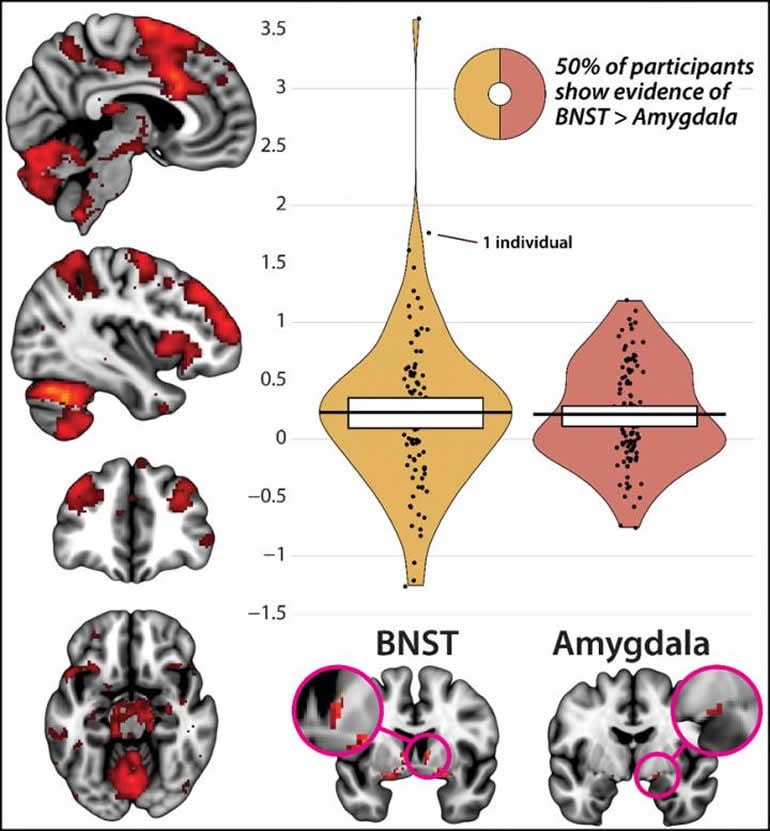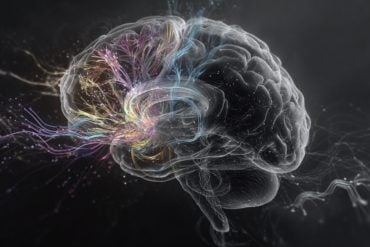Summary: Study provides contrary evidence to existing theory, finding anxiety and fear reflect overlapping neural circuits.
Source: SfN
Fear and anxiety reflect overlapping brain circuits, according to research recently published in Journal of Neuroscience. The findings highlight a need to reevaluate the existing models guiding anxiety research.
While “fear” and “anxiety” are often used interchangeably, prevailing scientific theory suggests that they are distinct, with different triggers and separate brain circuits.
Fear — a fleeting reaction to certain danger — is thought to be controlled by the amygdala, whereas anxiety — a persistent, heightened state of distress in response to uncertain threat — is thought to be orchestrated by the bed nucleus of the stria terminalis (BNST).
However, new evidence from Hur et al. suggests these two brain regions are equally sensitive to certain and uncertain threat.
The research team measured brain activity with fMRI while people anticipated receiving a painful shock paired with an unpleasant image and sound. Waiting for threat, whether predictable or not in its timing, recruited an overlapping network of brain regions including the BNST and the amygdala.

Across a variety of tests, the two structures showed statistically indistinguishable responses, suggesting that states of fear and anxiety are assembled from a common set of core neural building blocks.
These observations raise important questions about the U.S. National Institute of Mental Health’s model guiding research into the biology of emotional disorders.
About this neuroscience research article
Source:
SfN
Contacts:
Calli McMurray – SfN
Image Source:
The image is credited to Hur et al., JNeurosci 2020.
Original Research: Closed access
“Anxiety and the Neurobiology of Temporally Uncertain Threat Anticipation” by Juyoen Hur, Jason F. Smith, Kathryn A. DeYoung, Allegra S. Anderson, Jinyi Kuang, Hyung Cho Kim, Rachael M. Tillman, Manuel Kuhn, Andrew S. Fox and Alexander J. Shackman. Journal of Neuroscience.
Abstract
Anxiety and the Neurobiology of Temporally Uncertain Threat Anticipation
When extreme, anxiety—a state of distress and arousal prototypically evoked by uncertain danger—can be debilitating. Uncertain anticipation is a shared feature of situations that elicit signs and symptoms of anxiety across psychiatric disorders, species, and assays. Despite the profound significance of anxiety for human health and wellbeing, the neurobiology of uncertain-threat anticipation remains unsettled. Leveraging a paradigm adapted from animal research and optimized for functional MRI signal decomposition, we examined the neural circuits engaged during the anticipation of temporally uncertain and certain threat in 99 men and women. Results revealed that the neural systems recruited by uncertain and certain threat anticipation are anatomically co-localized in fronto-cortical regions, extended amygdala, and periaqueductal gray. Comparison of the threat conditions demonstrated that this circuitry can be fractionated, with fronto-cortical regions showing relatively stronger engagement during the anticipation of uncertain threat, and the extended amygdala showing the reverse pattern. Although there is widespread agreement that the bed nucleus of the stria terminalis and dorsal amygdala—the two major subdivisions of the extended amygdala—play a critical role in orchestrating adaptive responses to potential danger, their precise contributions to human anxiety have remained contentious. Follow-up analyses demonstrated that these regions show statistically indistinguishable responses to temporally uncertain and certain threat anticipation. These observations provide a framework for conceptualizing anxiety and fear, for understanding the functional neuroanatomy of threat anticipation in humans, and for accelerating the development of more effective intervention strategies for pathological anxiety.
SIGNIFICANCE STATEMENT
Anxiety—an emotion prototypically associated with the anticipation of uncertain harm—has profound significance for public health, yet the underlying neurobiology remains unclear. Leveraging a novel neuroimaging paradigm in a relatively large sample, we identify a core circuit responsive to both uncertain and certain threat anticipation, and show that this circuitry can be fractionated into subdivisions with a bias for one kind of threat or the other. The extended-amygdala occupies center-stage in neuropsychiatric models of anxiety, but its functional architecture has remained contentious. Here we demonstrate that its major subdivisions show statistically indistinguishable responses to temporally uncertain and certain threat. Collectively, these observations indicate the need to revise how we think about the neurobiology of anxiety and fear.






